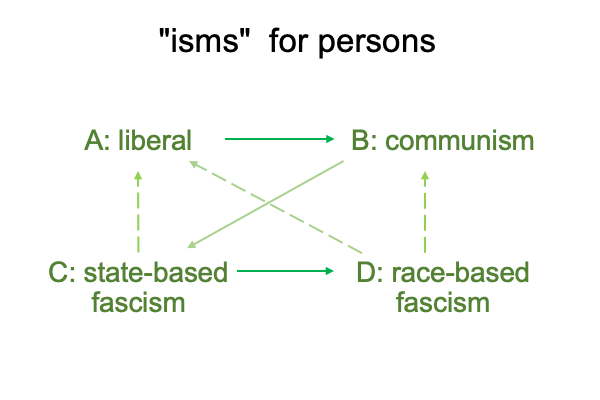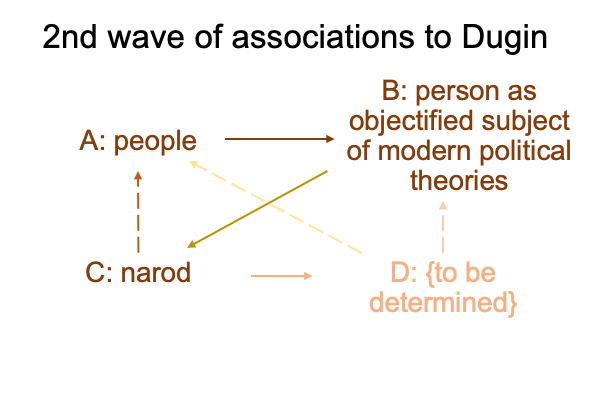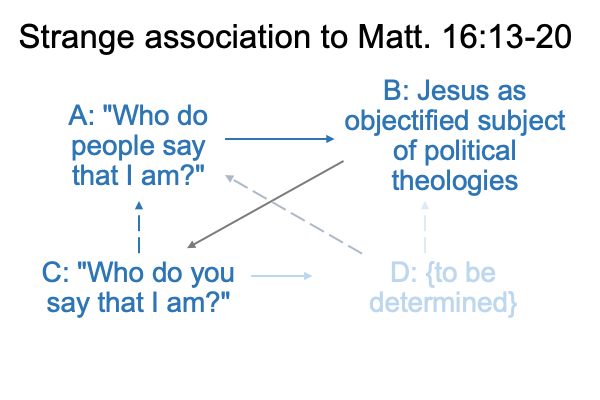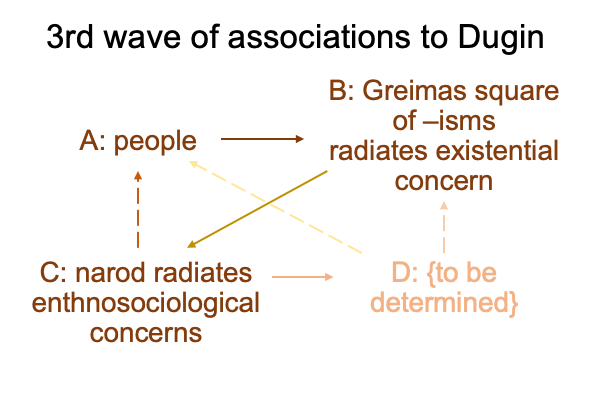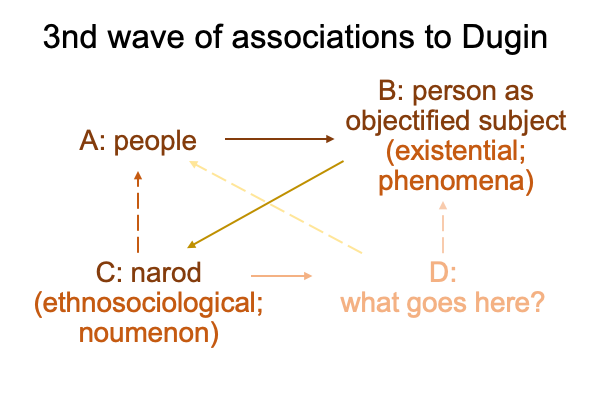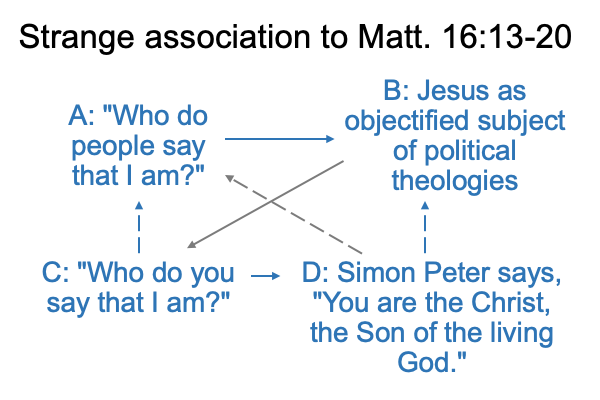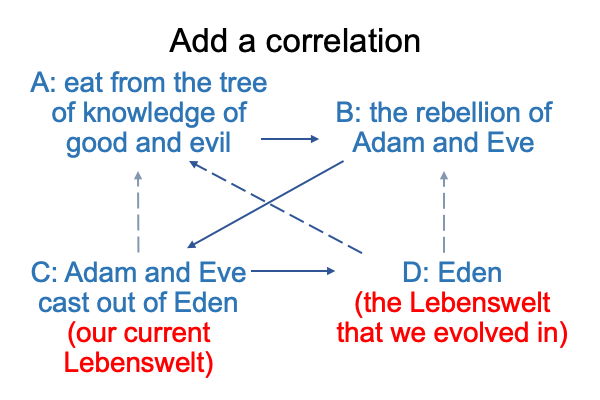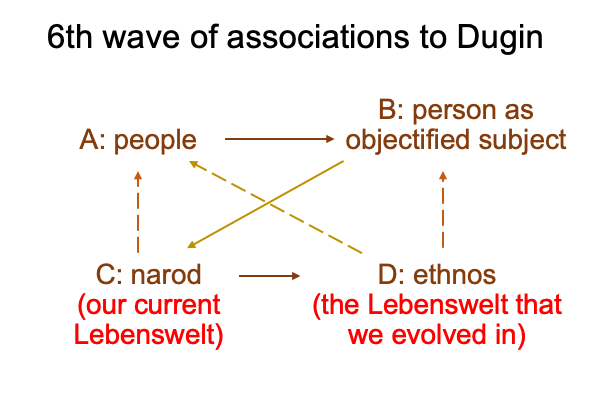Looking at Michael Millerman’s Chapter (2022) “…Dimensions of Dugin’s Populism” (Part 2 of 9)
0008 Okay, I am looking at chapter two of Inside Putin’s Brain, titled “The Enthosociological and Existential Dimensions of Dugin’s Populism”.
Does this title explain my blog’s title?
Obviously, there are two dimensions to Dugin’s view of people.
People?
Yeah, like “We, the People…”
The ethnosociological dimension addresses the question, “What is a people?”
The existential dimension addresses the question, “Why is there a people?”
Now, I move to a purely relational structure, the Greimas square.
Here is a picture.

A is the focal term, “people”.
B contrasts with the focal word, “people”. Here, I will put “person”.
C speaks against (the transliteration of “contradict”) B and complements A.
Right away, I see a technical term that Dugin uses. “Narod” is a Russian word that means “people”, in an us-versus-them sort of way. Narod is distinct from individual, class, state and race.
I ask, “What if narod goes into C?”

Once I put the word, “narod”, into C, the term, “person” in B, appears convoluted.
According, to Dugin, the narod contradicts individual, class, state and race. Plus, when I recall about how modern academics classify each person, they tend to do so according to easily observable and measurable features.
Plus, these classifications fit into a Greimas square.
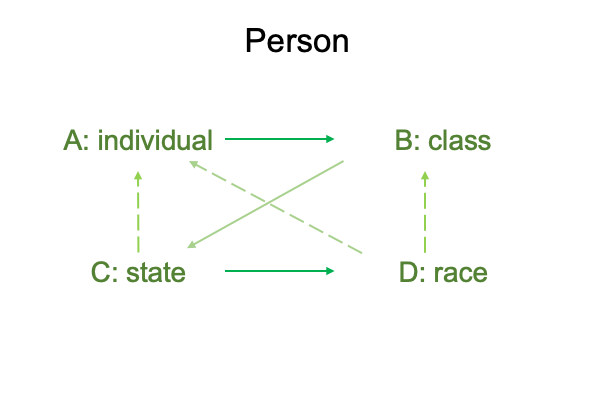
Obviously, the most phenomenal feature of a person is that the person is an individual. Liberalism models the phenomena of the individual. The individual is the subject. The phenomena of individuals give rise observations and measurements, that end up in models that liberal experts use.
Class contrasts with the focal word, “individual”. Class terms include “bourgeois” and “proletariat”. Working personsself-identify as the latter. Owners of various means of production are accused of being the former. The pattern extends into culture, by associating “class” with a person’s chosen identity. Technically, class is a style of righteousness that calls persons into organizations. Communists model observations and measurements of social phenomena on the basis of distinctions among classes.
The state contradicts (or “speaks against”) class. To appreciate the contradiction, replace “class” with “state” in the above technical definition. The state is also a style of righteousness that calls persons into organization. The state is an institution that is in charge of keeping peace among institutions. Class is tied to a feedback loop between institutions and persons. When, the state replaces class, the state confounds righteousness and social order.
State-based fascists model observations and measurements of social phenomena according to the state as arbiter of order and righteousness. Fascists consider individuals to be citizens. The state (as subject) takes priority over the individual (as subject). Hence, fascisms are called “il-liberal”.
Finally, what happens when “race” substitutes for “class” as a style of righteousness that calls persons into organization?
Well, once the subject is regarded in terms of “race”, then the state decides who is free and who is a slave. That implies that there are two classes, “free” and “slave”. Certain races are free and the other races are slaves.
Oddly, the assignment of “free” or “slave” is not necessarily based on phenotypic variation among populations. But, it is often enough the case. Members of the free “race” are regarded as citizens. Members of the slave “race” are not. Thus, race-based fascism fixates on who is a citizen and who is not.
Race-based fascists model observations and measurements of social phenomena according to the state serving as arbiter of who is free and who is slave.
0009 What does this apparent digression have to do with “the person” in slot B?
If the narod, the Russian word for “people”, goes into slot C, then the person in slot B is the person as the subject of inquiry, according to a modern science-inspired ideology (B). The result may be depicted by a Greimas square for the three political theories preceding Dugin’s proposed fourth political theory.
Here is a picture.
